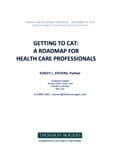Getting to CAT: A Roadmap for Health Care Professionals
Author(s): Stacey L. Stevens*
November 23, 2016
This paper is essential reading for any health care professional working with catastrophically (CAT) injured accident victims and interested in understanding the GOS-E. Personal injury lawyer Stacey L. Stevens provides a series of best practices to be followed in light of the recent changes to the catastrophic impairment definition ranging from the initial client interview to documenting your file and identifies the inherent flaw in the GOS-E and how, with your help, they can be overcome.
Paper excerpt:
The new definition of catastrophic impairment is perhaps the most challenging test in SABS history for adults who have suffered a traumatic brain injury in a motor vehicle collision. Not only has the Glasgow Coma Scale been replaced with the Glasgow Outcome Scale/Glasgow Outcome Scale-Extended, injured adults must also have positive findings on a computerized axial tomography scan or other medically recognized brain diagnostic technology. Assuming the new definition is met, these adults will only receive half the amount of medical/rehabilitation and attendant care benefits that were available prior to June 1st, 2016. This change represents a major shift in government policy. It moves away from ensuring seriously injured accident victims have prompt access to services during the acute injury phase to focusing on their functional outcome well after the onset of injury.
The elimination of the Glasgow Coma Scale has taken away the automatic catastrophic criterion. At a minimum, the most severely brain injured adults will have to wait 30 days before being deemed catastrophically impaired. Adults suffering a mild to moderate brain injury will have to wait at least 6 months before applying for the catastrophic impairment designation. This presents a host of problems for discharge, planners, case managers and other medical specialists who will struggle with assembling an appropriate community-based treatment team. The provision of intensive treatment and attendant care services will be postponed, reduced and in some cases eliminated. Family members will be put under immense pressure.
To add insult to injury, the quantum of available Statutory Accident Benefits has been dramatically reduced. For accidents occurring after June 1, 2016, medical, rehabilitation and attendant care benefits for catastrophically injured accident victims is capped at $1 million. Non-catastrophic benefits for these categories are a paltry $65,000[1].
The goal of this paper is a to provide a roadmap to understanding the new catastrophic definition and how to successfully document your client’s file to increase his/her ability to get to CAT.
The 2016 Catastrophic Impairment Definition
In order to successfully overcome the challenges present by the new catastrophic impairment definition, it is important to understand the wording contained within the Schedule. Firstly, the injury must be a traumatic brain injury (as opposed to a brain impairment, as set out in the previous version of the SABS)[2] diagnosed by a neuropsychologist who has been registered to practice neuropsychology in Canada for at least 5 years[3].
Secondly, as noted above, the traumatic brain injury must be supported by positive findings on a computerized axial tomography scan, MRI or other medically recognized brain diagnostic technology indicating intracranial pathology arising from the collision and a Glasgow Outcome Score – Extended score of[4]:
(a) Vegetative State (VS or VS*), one month or more after the accident,
(b) Upper Severe Disability (Upper SD or Upper SD*) or Lower Severe Disability (Lower SD or Lower SD*), six months or more after the accident, or
(c) Lower Moderate Disability (Lower MD or Lower MD*), one year or more after the accident.
Understanding the Glasgow Outcome Scale/Extended (GOS-E)
The Glasgow Outcome Scale-Extended (GOS-E) is a practical index of social outcome following a head injury. It represents a simple, hierarchical rating scale that acknowledges a traumatic brain injury can seriously impair a person’s quality of life at different points of time[5] and itself relies answers to questions focused on a limited number of broad categories. How the person scores on this test determines how their brain injury has affected function in major areas of life. It is the most widely used and accepted measure of outcome[6].
Conversely, it is a very basic test that is administered by way of a short unstructured interview. There are no written components other than the assessor’s notes. The questions are open-ended, rely on patient compliance and encourage a subjective use of the scale. More often than not brain injured individuals lack insight into the full extent of their deficits and under report their ability to function in the real world. They are euphoric and oblivious to obvious personality changes which can be the commonest and most disabling sequele that is not dependent on the presence of neurological deficits6. There is an inherent risk of systemic bias and under / over estimation of the injured client’s true functional state. Overall, the GOS-E gives a general indication of outcome and does not identify the person’s specific functional impairments.
In response to these establish flaws found in the GOS-E test, J. T. Lindsay Wilson, Laura E. L. Pettigrew and Graham M. Teasdale conducted extensive research and developed a set of standards for administering the GOS-E. These standards are contained in their paper entitled Structured Interviews for the Glasgow Outcome Scale and the Extended Glasgow Outcome Scale: Guidelines for Their Use [7]. The paper is attached. The Guidelines are summarized as follows:
- Disability due to head injury is defined by a change from pre-injury status;
- The scale is designed to assess changes and restrictions that have taken place as a result of the head injury. Questions regarding pre-existing disability status make it possible to assess outcome after head injury.
- Only pre-injury status and current status should be considered;
- Do not consider:
- the initial state after the injury;
- hopes for the future;
- the fact that the person has made a remarkable recovery considering their initial state;
- Do not consider:
- Disability must be a result of a mental or physical impairment
- Not all changes following the event are due to the injury;
- About capability to do the activity regardless of whether they actually do it;
- Note: Sometimes the precise question that is being asked is hypothetical: what exactly is the patient capable of even though they do not actually do it? If the answer to a question indicates that the head-injured person has some difficulty in a particular area, then it may be necessary to probe more deeply. After most of the main questions is a note amplifying the hypothetical issue that is being addressed, and there are further notes below. If necessary, the questioning should be continued to determine the answer to the hypothetical question.
- Use the best source of information available.
- Be aware of the circumstances in which the information may be misleading;
- Interview collateral sources if the person lacks insight;
- Most people with a brain injury will deny psychological change;
- A return to pre-collision activity such as work or school should not be given much weight as special accommodations may have been made that enable the person to do the activity;
- Contradictory or inconsistent responses is a signal to dig deeper or interview a collateral source;
- Further consideration may indicate that such a person should be considered to be moderately disabled rather than severely disabled, that is, that they are capable of activities of independence outside the home, even if they have some particular difficulties with them;
- Complete the entire questionnaire.
- Be aware of the circumstances in which the information may be misleading;
These Guidelines have been accepted by the medical community and in particular, have been incorporated catastrophic definition in the SABS by requiring assessors administering the GOS-E to complete the testing in accordance with these Guidelines.
Read full paper in PDF format: Getting to CAT: A Roadmap for Health Care Professionals

[1] In cases where the collision occurs after June 1st 2016 but the client’s insurance policy renews after June 1st 2016 the old limits remain available but the new CAT definition applies.
[2] s.45 Statutory Accident Benefits Schedule
[3] s.3(1) Statutory Accident Benefits Schedule
[4] s.3.1(1) 1 Statutory Accident Benefits Schedule
[5] Jennett, B. and Bond M., Assessment of Outcome after Severe Brain Damage, The Lancet, March 1, 1975, pp.480-484.
[6] whttps://www.abiebr.com/set/17-assessment-outcomes-following-acquiredtraumatic-brain-injury/glasgow-outcome-scaleextended
[7] Wilson, Pettigrew, Teasdale; Structured Interviews for the Glasgow Coma Scale and the Extended Glasgow Outcome Scale for their Use, Journal of Neurotrauma, Vol. 15, Number 9, 1998 at p.574-575.
Share this




